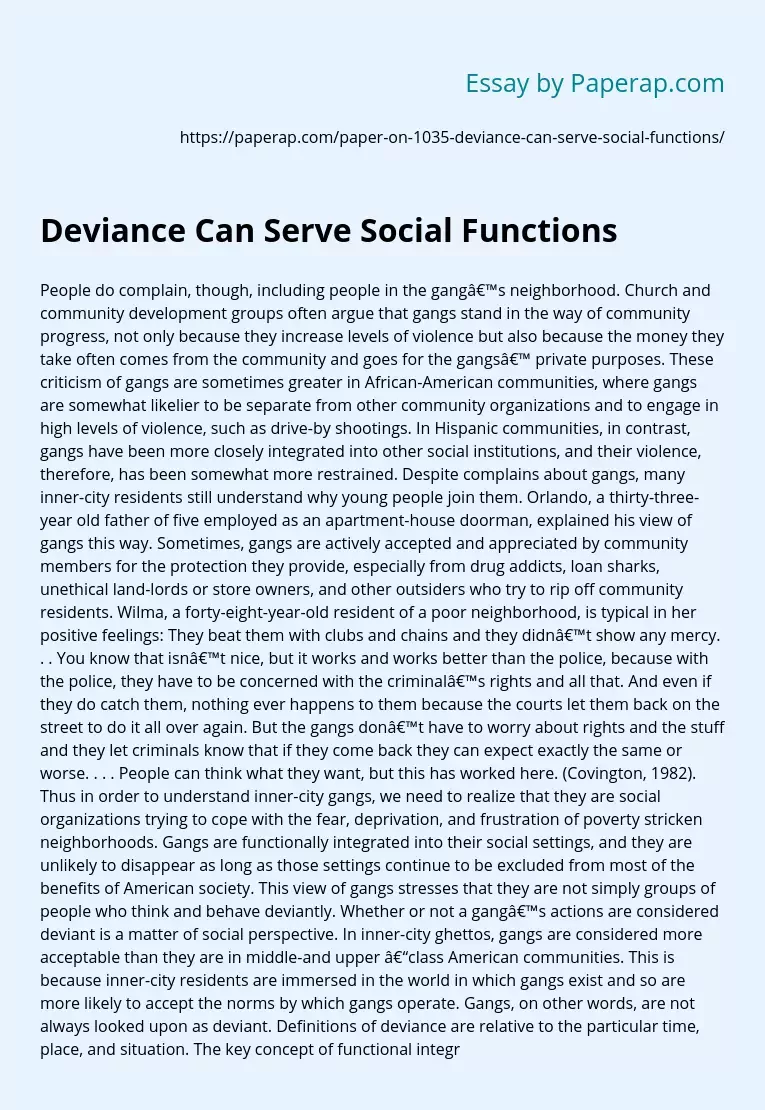Deviance Can Serve Social Functions
People do complain, though, including people in the gang’s neighborhood. Church and community development groups often argue that gangs stand in the way of community progress, not only because they increase levels of violence but also because the money they take often comes from the community and goes for the gangs’ private purposes. These criticism of gangs are sometimes greater in African-American communities, where gangs are somewhat likelier to be separate from other community organizations and to engage in high levels of violence, such as drive-by shootings.
In Hispanic communities, in contrast, gangs have been more closely integrated into other social institutions, and their violence, therefore, has been somewhat more restrained. Despite complains about gangs, many inner-city residents still understand why young people join them. Orlando, a thirty-three-year old father of five employed as an apartment-house doorman, explained his view of gangs this way.
Sometimes, gangs are actively accepted and appreciated by community members for the protection they provide, especially from drug addicts, loan sharks, unethical land-lords or store owners, and other outsiders who try to rip off community residents.
Wilma, a forty-eight-year-old resident of a poor neighborhood, is typical in her positive feelings: They beat them with clubs and chains and they didn’t show any mercy. . . You know that isn’t nice, but it works and works better than the police, because with the police, they have to be concerned with the criminal’s rights and all that.
And even if they do catch them, nothing ever happens to them because the courts let them back on the street to do it all over again.
But the gangs don’t have to worry about rights and the stuff and they let criminals know that if they come back they can expect exactly the same or worse. . . . People can think what they want, but this has worked here. (Covington, 1982). Thus in order to understand inner-city gangs, we need to realize that they are social organizations trying to cope with the fear, deprivation, and frustration of poverty stricken neighborhoods.
Gangs are functionally integrated into their social settings, and they are unlikely to disappear as long as those settings continue to be excluded from most of the benefits of American society. This view of gangs stresses that they are not simply groups of people who think and behave deviantly. Whether or not a gang’s actions are considered deviant is a matter of social perspective. In inner-city ghettos, gangs are considered more acceptable than they are in middle-and upper –class American communities.
This is because inner-city residents are immersed in the world in which gangs exist and so are more likely to accept the norms by which gangs operate. Gangs, on other words, are not always looked upon as deviant. Definitions of deviance are relative to the particular time, place, and situation. The key concept of functional integration, as well said before, can help us to analyze and understand deviance. Not only does deviance sometimes disrupt well-integrated social systems, but it can also, in the process, serve some positive social functions.
Emile Durkheim, one of sociology’s founders, was the first to discuss this seeming paradox. Durkheim argued that deviance is a natural part of social life, indeed “an integral part of all healthy societies. What did he mean by this? How can deviance be healthy for societies? Durkheim’s answer has two parts. First, in defining certain kinds of behavior as deviant, a group of community also defines what behavior is acceptable. The boundaries between acceptable and unacceptable are rarely hard and fast.
Societies typically have a “permissive zone of variation” (in Durkheim’s words) surrounding even strongly supported and quite specific norms. Most norms, however, are not expressed in highly specific ways. Rather, they are defined informally in the course of people’s day-t-day activities. By testing the boundaries of permissiveness, deviance force other members of society to think about what they believe is normal and right. Deviance can also be good for society in that it tends to unite members in opposition to the deviant, thus reaffirming their social solidarity.
When people in the Old West formed a posse, when parents unite to fight a pornography shop in their town, when citizens vote for a new, more honest politician, they are united by a sense of shared courage against a deviant – the outlaw who stole their horses, the merchant who opened the pornography store, the unethical politician who accepted bribes. Public opposition and punishment of deviants not only reaffirm norms that were threatened but also allow members of a community to pour their collective energy into shoring up the social order.
Deviance Can Serve Social Functions. (2017, May 20). Retrieved from https://paperap.com/paper-on-1035-deviance-can-serve-social-functions/

